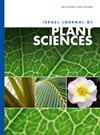The contribution of cell wall remodeling and signaling to lateral organs formation
IF 0.9
4区 生物学
Q4 PLANT SCIENCES
引用次数: 13
Abstract
Lateral organs are formed in plants by post embryonic developmental programs. Leaves, and flowers differentiate from the shoot apical meristem and lateral roots from the primary root pericycle meristem. Adventitious roots are roots formed from non-root lateral meristematic tissues, mostly the cambium, in many cases in response to stress signals. The ability of plants to regenerate adventitious roots is fundamental for selection and breading programs which are based on vegetative propagation of elite clones. Thus, recalcitrant plants, losing their rooting capability, may form a genuine commercial barrier in agricultural and forestry improvement programs. Some cellular mechanisms underlying adventitious root formation have been revealed, but much is yet to be clarified. The plant primary cell wall is a dynamic organ that can change its form, and perceive and relay molecular signals inward and outward during certain stages of development in particular cells. Therefore, before the secondary cell wall is deposited and plants become the wood from which walls and furniture are built, and the fibers from which cloths are woven, primary cell walls actively participate in plant cell differentiation and developmental programs. While auxin is a major regulator, cell walls are important in regulating coherent formative cell division and synchronized polar elongation of cell lineages that are necessary for lateral organ induction and formation, and collaborative cell functioning. Nevertheless, little is known of how cell wall changes are molecularly sensed and translated to intracellular signals during differentiation of adventitious roots. Here we summarize recent data linking, directly or indirectly, cell wall events to auxin signaling and to lateral or adventitious root induction and formation.细胞壁重塑和信号传导对侧壁器官形成的贡献
侧方器官是通过胚胎后发育程序在植物中形成的。叶和花从茎尖分生组织分化而来,侧根从主根中柱分生组织分裂而来。不定根是由非根侧分生组织(主要是形成层)形成的根,在许多情况下是对应激信号的反应。植物再生不定根的能力是基于优良无性系营养繁殖的选择和育种计划的基础。因此,顽固植物失去生根能力,可能会在农业和林业改良计划中形成真正的商业障碍。不定根形成的一些细胞机制已经被揭示,但还有很多尚待澄清。植物原代细胞壁是一个动态器官,可以改变其形态,并在特定细胞发育的某些阶段向内和向外感知和传递分子信号。因此,在次生细胞壁沉积之前,植物成为建造墙壁和家具的木材,以及编织布料的纤维之前,原生细胞壁积极参与植物细胞分化和发育程序。虽然生长素是一种主要的调节因子,但细胞壁在调节连贯的形成性细胞分裂和细胞谱系的同步极性延伸方面很重要,这是侧向器官诱导和形成以及协同细胞功能所必需的。然而,在不定根分化过程中,细胞壁的变化是如何被分子感知并转化为细胞内信号的,目前还知之甚少。在这里,我们总结了最近的数据,直接或间接地将细胞壁事件与生长素信号传导以及侧根或不定根的诱导和形成联系起来。
本文章由计算机程序翻译,如有差异,请以英文原文为准。
求助全文
约1分钟内获得全文
求助全文
来源期刊

Israel Journal of Plant Sciences
生物-植物科学
CiteScore
1.90
自引率
0.00%
发文量
17
审稿时长
>12 weeks
期刊介绍:
The Israel Journal of Plant Sciences is an international journal of extensive scope that publishes special issues dealing with all aspects of plant sciences, including but not limited to: physiology, cell biology, development, botany, genetic
 求助内容:
求助内容: 应助结果提醒方式:
应助结果提醒方式:


